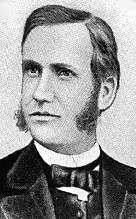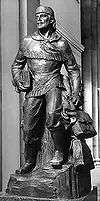Marcus Whitman
| Marcus Whitman | |
|---|---|
 | |
| Born |
September 4, 1802 Federal Hollow, New York |
| Died |
November 29, 1847 (aged 45) Waiilatpu, Oregon Country |
| Education | Fairfield Medical College |
| Spouse(s) | Narcissa Prentiss |
| Church | Methodist |
Congregations served | Whitman Mission |
| Title | Missionary |
Marcus Whitman (September 4, 1802 – November 29, 1847) was an American physician and missionary in the Oregon Country. Along with his wife, Narcissa, he started a mission to the Cayuse in what is now southeastern Washington state in 1836. The area later developed as a trading post and stop along the Oregon Trail, and the city of Walla Walla, Washington developed near there.
In 1843 Whitman led the first large party of wagon trains along the Oregon Trail to the West, establishing it as a viable route for the hundreds of thousands of immigrants who used the trail in the following decade. Settlers encroached on the Cayuse near the Whitman mission. Following the deaths of all the Cayuse children and half their adults from a measles epidemic in 1847, in which the Cayuse suspected the Whitmans' responsibility, they killed the Whitmans and 12 other settlers in what became known as the Whitman Massacre. Continuing warfare by settlers reduced the Cayuse numbers further and they eventually joined the Nez Perce tribe to survive.
Early life
On September 4, 1802, Whitman was born in Federal Hollow, New York to Alice and Beza Whitman.[1] Their immigrant paternal ancestor was John Whitman, who immigrated to the Massachusetts Bay Colony before 1639 from England.[1] After his father's death when Whitman was seven, he was sent to Massachusetts to live with his uncle.[1]
Whitman dreamed of becoming a minister but did not have the money for such schooling. As a young man, he had returned to New York. He studied medicine for two years with an experienced physician under the form of apprenticeship approved then, and received his degree from Fairfield Medical College in New York. He practiced for a few years in Canada but was interested in going to the west.
Missionary
In 1834 Whitman applied to the American Board of Commissioners for Foreign Missions. They initially denied him for health reasons, but he was later accepted as a missionary doctor. In 1835, he traveled with the missionary Samuel Parker to present-day northwestern Montana and northern Idaho, to minister to bands of the Flathead and Nez Percé nations. During this journey, Whitman treated several fur trappers during an outbreak of cholera. At the end of their stay, he promised the Nez Percé that he would return with other missionaries and teachers to live with them.
After his return to New York, Whitman attended a speech by Parker, who then represented the American Board of Commissioners for Foreign Missions. He called for missionaries for the west. Whitman volunteered again to go there.
Marriage and family
In 1836, Whitman married Narcissa Prentiss, a teacher of physics and chemistry. She had also been eager to travel west as a missionary, but she had been unable to do so as a single woman. They had one daughter, Alice Clarissa, born On March 14, 1837, the first Anglo-American child born in Oregon Country. She was named after her grandmothers. Unfortunately, she drowned in the Walla Walla River at age two.[2]
As settlers came in increasing numbers, the Whitmans took in eleven orphaned children, including the adoption of the Sager orphans. They also established a kind of boarding school for settlers' children at their mission.[3]
The way west
On May 25, 1836, the Whitmans, and a group of other missionaries including Henry and Eliza Spalding, joined a caravan of fur traders and traveled west. The fur company caravan was led by the mountain men Milton Sublette and Thomas Fitzpatrick. The fur traders had seven covered wagons, each pulled by six mules. An additional cart drawn by two mules carried Milton Sublette, who had lost a leg a year earlier and walked on a "cork" one made by a friend. The combined group arrived at the fur-traders' annual rendezvous on July 6.
The group established several missions as well as Whitman's settlement at a Cayuse settlement called Waiilatpu (Why-ee-lat-poo, the 't' is half silent) in the Cayuse language, meaning "place of the rye grass". It was located just west of the northern end of the Blue Mountains. The present-day city of Walla Walla, Washington developed six miles to the east. The settlement was in the territory of both the Cayuse and the Nez Percé tribes. Whitman farmed and provided medical care, while Narcissa set up a school for the Native American children.
In 1843, Whitman traveled east, and on his return he helped lead the first large group of wagon trains west from Fort Hall, in southeastern Idaho. Known as the "Great Emigration", it established the viability of the Oregon Trail for later homesteaders. Not having much success with converting the Cayuse, the Whitmans gave more attention to the settlers. They took in children to their own home and established a boarding school for settlers' children.[3]
Massacre
The Cayuse resented the encroachment of European Americans. More significantly, the influx of white settlers in the territory brought new infectious diseases to the Indian tribes, including a severe epidemic of measles in 1847. The Native Americans lack of immunity to Eurasian diseases resulted in high death rates, with children dying in striking numbers. The Whitmans cared for both Cayuse and white settlers, but half of the Cayuse died and nearly all their children. Seeing that more whites survived, the Cayuse blamed the Whitmans for the devastating deaths among their people.[3]
The Cayuse tradition held medicine men personally responsible for the patient's recovery. Their despair at the deaths, especially of their children, led the Cayuse under Chief Tiloukaikt to kill the Whitmans in their home on November 29, 1847. Warriors destroyed most of the buildings at Waiilatpu and killed twelve other white settlers in the community. The events became known among European-American settlers as the Whitman Massacre. The Cayuse held another 53 women and children captive for a month before releasing them through negotiations. These events, and continued European-American encroachment, triggered a continuing conflict between the occupying white settlers and the Cayuse that became known as the Cayuse War. They were so reduced in number that survivors joined the Nez Percé tribe.[3]
Historians have noted contemporary accounts of competition between the Protestant missionaries and Catholic priests, who had become established with Jesuit missions from Canada and St. Louis, Missouri, as contributing to the tensions. The Roman Catholic priest John Baptiste Brouillet aided the survivors and helped bury the victims. The Rev. Henry H. Spalding later wrote a pamphlet stating forcefully that the Catholic priests, including Father Brouillet, had incited the Cayuse to massacre.
"Spalding's version of the disaster was printed and reprinted, sometimes at taxpayer expense, for the next half-century. It was finally discredited in 1901 by Yale University historian Edward Gaylord Bourne."[4][5]
Legacy

Whitman is commemorated by Whitman College in Walla Walla, Whitman County, Washington,[6] the Wallowa–Whitman National Forest, Mount Rainier's Whitman Glacier,[7] and numerous schools, including Marcus Whitman Central School in Rushville, New York, his hometown. In 1953, the state of Washington donated a statue of him by the sculptor Avard Fairbanks to the National Statuary Hall Collection in the United States Capitol. An identical one stands at the edge of the campus of Whitman College. The Washington State Legislature has declared the fourth day of September as Marcus Whitman Day. A bronze tablet in Wheeler, New York commemorates his 1828-1835 practice as a medical doctor in that town.[8] In 1977, he was inducted into the Steuben County (NY) Hall of Fame.[9]
See also
References
- 1 2 3 National Park Service: Biography of Marcus Whitman
- ↑ Allen, Opal Sweazea. Narcissa Whitman: An Historical Biography, Binfords & Mort, 1959
- 1 2 3 4 The West: "Marcus & Narcissa Whitman", 2001, PBS, accessed 30 April 2012
- ↑ Edward Gaylord Bourne, "The myth of Marcus Whitman", American Historical Review of January 1901.
- ↑ History of the Catholic Sentinel, official website
- ↑ Meany, Edmond S. (1923). Origin of Washington geographic names. Seattle: University of Washington Press. p. 348.
- ↑ Majors, Harry M. (1975). Exploring Washington. Van Winkle Publishing Co. p. 125. ISBN 978-0-918664-00-6.
- ↑ Appelbee, Lenora J., Around Prattsburgh, Arcadia Publishing, 2012.
- ↑ Steuben County Hall of Fame, 2013
External links
- Marcus and Narcissa Whitman and the Opening of Old Oregon by Clifford M. Drury at Whitman Mission National Historic Site
- Whitman at the Architect of the Capitol
- The West: "Marcus & Narcissa Whitman", 2001, PBS
- The Marcus Whitman Trail Route Historical Marker
 Texts on Wikisource:
Texts on Wikisource:
- "Whitman, Marcus". Collier's New Encyclopedia. 1921.
- "Whitman, Marcus". Encyclopedia Americana. 1920.
- "Whitman, Marcus". Encyclopædia Britannica (11th ed.). 1911.
- "Whitman, Marcus". New International Encyclopedia. 1905.
- "Whitman, Marcus". Appletons' Cyclopædia of American Biography. 1889.
- Review: Acquisition of Oregon and the long suppressed evidence about Marcus Whitman by Leslie M. Scott in the Oregon Historical Quarterly (1912).
- Edwards, G. Thomas. "Marcus Whitman". The Oregon Encyclopedia.
